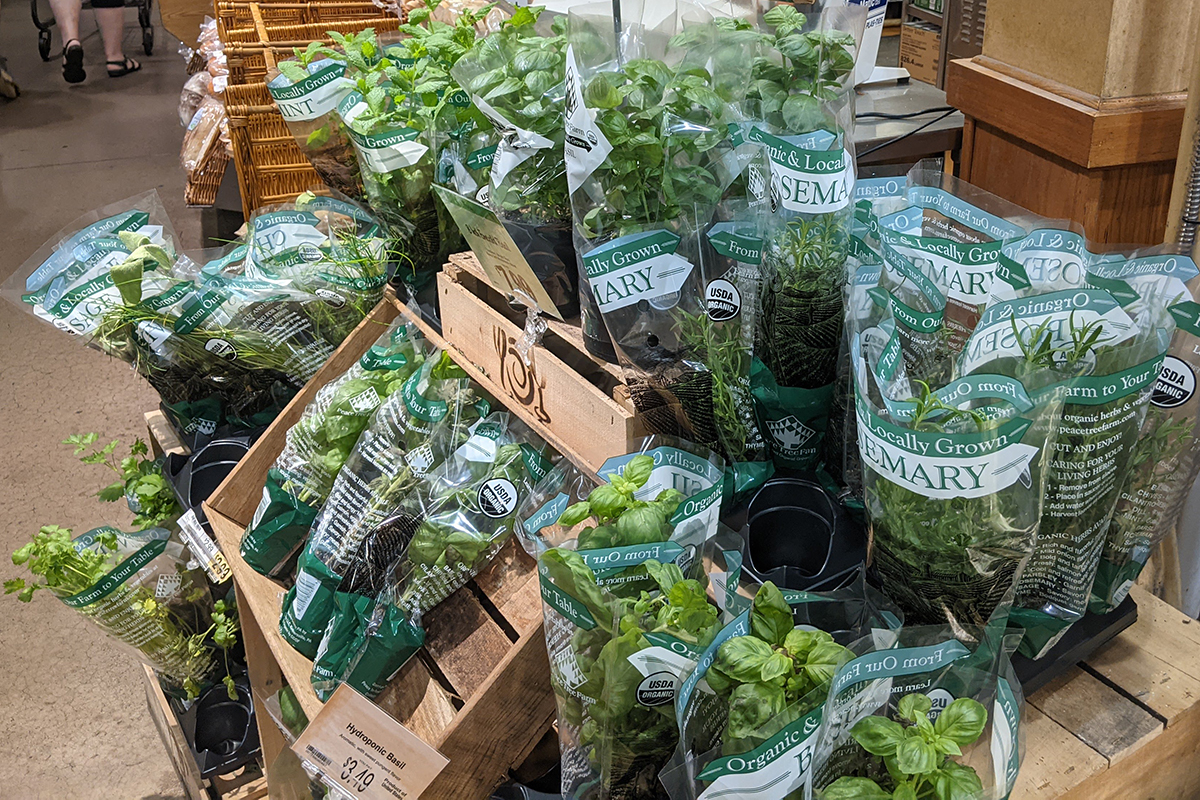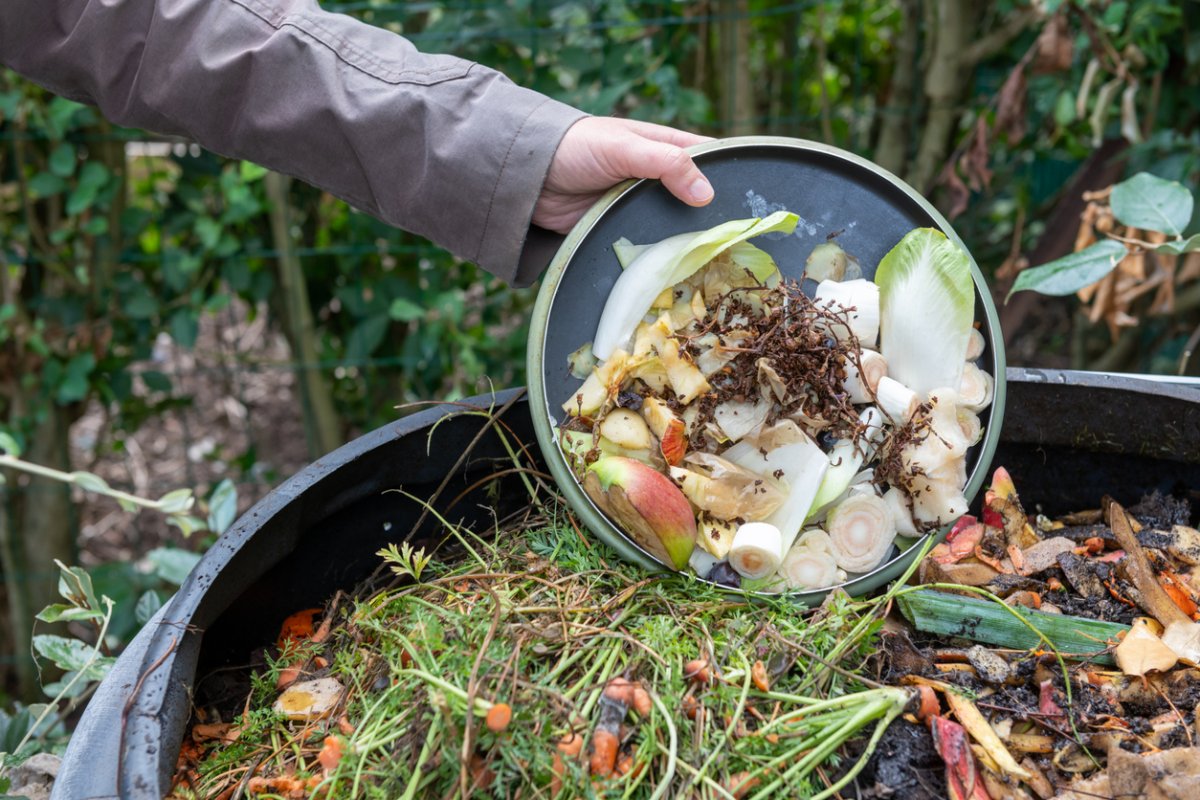Home>Gardening Tips and Tricks>Problem Solving>How To Keep Herbs Alive


Problem Solving
How To Keep Herbs Alive
Modified: January 22, 2024
Learn problem-solving techniques to keep your herbs alive and thriving! Discover useful tips and tricks to overcome common challenges and cultivate a green-thumb.
(Many of the links in this article redirect to a specific reviewed product. Your purchase of these products through affiliate links helps to generate commission for Chicagolandgardening.com, at no extra cost. Learn more)
Table of Contents
Introduction
Have you ever tried growing your own herbs, only to see them wilt and wither away within days? Keeping herbs alive can be a challenge, especially for those without a green thumb. But fear not, as we have some helpful tips to ensure your herbs thrive and stay healthy!
Herbs not only add flavor and fragrance to your dishes, but they also have numerous health benefits. From basil and mint to rosemary and thyme, each herb brings its unique essence to your culinary creations. But to fully enjoy the flavors and benefits, you need to keep your herbs alive and thriving.
In this article, we will explore the essential steps for successfully nurturing your herb garden. We will discuss everything from choosing the right herbs and providing adequate sunlight to proper watering techniques and preventing pests and diseases. By following these tips and tricks, you can enjoy a bountiful herb garden and add a touch of freshness to every meal.
Before we dive into the details, it’s important to note that different herbs have different requirements. While some may prefer full sunlight, others thrive in partial shade. Similarly, each herb has specific watering needs, and some may be more susceptible to pests than others. So, it’s crucial to understand the specific requirements of the herbs you plan to grow.
So, whether you’re a seasoned gardener looking to improve your herb-growing skills or a beginner hoping to keep your herbs alive, this article will provide you with the guidance you need. Let’s explore the secrets to successful herb gardening and ensure a flourishing bounty of fragrant and flavorful herbs!
Choosing the Right Herbs
Choosing the right herbs is the first step towards keeping them alive and thriving. Consider your preferences and the purpose of cultivating herbs, whether it’s for culinary use, medicinal purposes, or simply for aesthetic appeal. Here are some factors to keep in mind when selecting herbs:
- Climate and Growing Conditions: Herbs have different climate preferences, so it’s important to choose herbs that are suitable for your region. Some herbs thrive in warm climates, while others prefer cooler temperatures. Additionally, consider the amount of sunlight your herb garden receives and choose herbs accordingly.
- Usage: Think about how you plan to use the herbs. Are you looking for herbs to enhance your cooking? If so, consider popular culinary herbs such as basil, parsley, rosemary, and thyme. For medicinal purposes, look into herbs like chamomile, lavender, and echinacea. And if you’re aiming to create an aromatic garden, go for scented herbs like mint, lemon balm, and sage.
- Space and Growth Habit: Take into account the space available for your herb garden. Some herbs, like mint and oregano, tend to spread and can become invasive if not contained. On the other hand, herbs like cilantro and dill have a shorter lifespan and may require frequent replanting.
- Personal Preference: Ultimately, choose herbs that you enjoy and are likely to use. Consider the flavors and scents that appeal to you and align with your cooking style or wellness needs.
Once you have decided on the herbs to grow, it’s time to move on to the next steps of ensuring their survival. Remember, choosing the right herbs sets the foundation for a healthy and successful herb garden.
Providing Adequate Sunlight
Adequate sunlight is essential for the growth and vitality of herbs. Most herbs thrive in full sunlight, which is typically at least six hours of direct sunlight per day. Here are some tips for providing your herbs with the right amount of sunlight:
- Choose the Right Location: Select a location for your herb garden that receives ample sunlight. Look for an area that is not shaded by trees or buildings for most of the day.
- Observe the Sun Patterns: Take note of how the sunlight moves across your chosen location throughout the day. Ensure that your herbs will receive the recommended six hours of direct sunlight.
- Consider Partial Shade Herbs: If you have limited sunlight in your garden, opt for herbs that can tolerate partial shade. Some herbs, such as mint, chives, and parsley, can still grow well with a few hours of direct sunlight and partial shade during the rest of the day.
- Use Reflective Surfaces: If your herb garden is in an area with limited sunlight, make use of reflective surfaces like white stones or white-painted walls to help redirect and maximize the available sunlight.
Remember that providing adequate sunlight not only helps herbs grow but also intensifies their flavors and aromas. However, be cautious of excessive heat in summer months, as it can cause some herbs to wilt or dry out. Regularly monitor your herbs’ condition and make adjustments to their sunlight exposure if needed.
Watering Techniques
Proper watering is crucial for the survival and health of herbs. Finding the right balance can be tricky, as overwatering can lead to root rot, while underwatering can cause wilting and stunted growth. Here are some watering techniques to help keep your herbs hydrated:
- Check Soil Moisture: Before watering, check the moisture level of the soil by inserting your finger about an inch deep. If the soil feels dry, it’s time to water your herbs.
- Water the Soil, Not the Leaves: Direct your watering efforts towards the soil around the herbs, rather than spraying water on the leaves. Wet leaves can promote the growth of fungal diseases.
- Water in the Morning: Water your herbs in the morning to allow sufficient time for the foliage to dry out during the day. This helps prevent the growth of mildew and other moisture-related issues.
- Use a Soaker Hose or Drip Irrigation: Consider using a soaker hose or drip irrigation system, as these methods deliver water directly to the soil. This reduces water waste and ensures that the water reaches the roots efficiently.
- Apply Water Slowly: When hand-watering your herbs, apply water slowly to allow it to penetrate deeply into the soil. This encourages the roots to grow deeper and makes the herbs more resilient to drought.
- Adjust according to Weather Conditions: Adapt your watering routine based on the weather conditions. During hot and dry periods, you may need to water more frequently, while cooler and rainy periods may require less frequent waterings.
Remember that the watering needs of herbs may vary depending on factors such as the size of the pot or garden, the type of soil, and the specific herb itself. Regularly check the moisture levels and observe the overall health of your herbs to determine the optimal watering frequency.
Proper Soil and Drainage
Choosing the right soil and ensuring proper drainage are vital for the overall health and growth of herbs. Here are some tips to help you provide the ideal soil conditions for your herb garden:
- Select Well-Draining Soil: Herbs prefer soil that drains well to avoid waterlogged roots. Use a well-draining soil mix that combines organic matter, such as compost or peat moss, with perlite or sand to improve drainage.
- Test Soil pH: Most herbs prefer slightly acidic to neutral soil with a pH range of 6.0 to 7.0. Test the pH of your soil using a soil testing kit and make adjustments if necessary by adding soil amendments like lime or sulfur.
- Avoid Compacted Soil: Avoid using heavy or compacted soil, as it can lead to poor drainage and hinder root development. Loosen the soil before planting by using a garden fork or tiller, creating a loose and friable texture.
- Container Gardening: If you’re growing herbs in containers, ensure they have drainage holes at the bottom. Use a well-draining potting mix specifically formulated for herbs or create your own by combining equal parts of peat moss, vermiculite, and perlite.
- Improve Drainage: If your soil has poor drainage, consider adding organic matter or coarse sand to improve its structure and allow for better water movement through the soil.
Proper soil and drainage help prevent waterlogged roots, which can lead to root rot and other diseases. Additionally, they allow the herbs’ roots to access the necessary nutrients for growth and development. Be mindful of the specific soil and drainage requirements of each herb, as some may have different preferences.
Temperature and Humidity Control
Creating a suitable environment with the right temperature and humidity levels is crucial for the health and survival of your herbs. Each herb has its own temperature and humidity preferences, so it’s essential to provide the optimal conditions for their growth. Here are some tips for controlling temperature and humidity:
- Know the Herb’s Preferences: Research the specific temperature and humidity requirements of the herbs you’re growing. Some herbs, like basil and cilantro, thrive in warm temperatures, while others, like parsley and mint, prefer cooler conditions.
- Outdoor Placement: If you’re growing herbs outdoors, choose a location that offers protection from extreme temperatures, such as strong winds or excessive heat. Consider using shade cloth or a greenhouse to regulate temperature and protect your herbs.
- Indoor Herb Garden: If growing herbs indoors, provide adequate ventilation to maintain fresh air circulation and prevent stagnant air. Consider using a fan or opening windows periodically to control temperature and humidity.
- Monitor Indoor Temperatures: Ensure that indoor temperatures stay within the preferred range for your herbs. Avoid placing herbs near sources of heat, such as radiators or stoves, as they can cause stress or damage to the plants.
- Humidity Control: Different herbs have varying humidity preferences. Some herbs, like rosemary and thyme, prefer lower humidity levels, while others, like basil and cilantro, benefit from higher humidity. Use a humidity monitor to assess and adjust humidity levels accordingly.
- Misting: If your indoor herb garden requires higher humidity, misting the plants with water can help create a more suitable environment. Use a spray bottle to lightly mist the leaves without soaking the soil.
- Protect from Cold: During colder months, provide protection for herbs that are sensitive to low temperatures. Bring potted herbs indoors or use protective coverings like row covers or cloths to shield them from frost.
By maintaining the right temperature and humidity levels, you can promote healthy growth and prevent stress-related issues like wilting or yellowing leaves. Understanding the needs of your herbs and making adjustments accordingly will help to ensure their long-term survival.
Pruning and Harvesting Tips
Pruning and harvesting herbs is not only essential for maintaining their shape and size but also promotes healthy growth and encourages continuous production. Proper pruning techniques and timing ensure that your herbs remain robust and productive. Here are some tips for effective pruning and harvesting:
- Promote Bushier Growth: Regularly pinch back or trim the tips of your herbs to encourage bushier growth. This helps the plant develop more branches and foliage, leading to a fuller and more abundant herb garden.
- Remove Dead or Damaged Leaves: Regularly inspect your herbs for any dead, yellowed, or damaged leaves. Removing these leaves not only improves the appearance but also prevents the spread of diseases and pests.
- Pinch off Flower Buds: Many herbs, like basil or mint, tend to produce flower buds as they mature. Removing these buds helps divert the plant’s energy towards foliage growth rather than flower production, ensuring a more robust and flavorful harvest.
- Harvest Frequently and Properly: Harvest herbs regularly to encourage continued growth and prevent the herbs from becoming overgrown. When harvesting, use clean and sharp shears or scissors to make clean cuts just above a set of leaves or nodes.
- Harvest in the Morning: Harvest herbs in the morning when their essential oils are at their peak. This is when the flavors and aromas are most potent.
- Leave Some Foliage: When harvesting, avoid removing all the leaves from a single stem. Leave at least a third of the foliage intact, as this ensures the herb can continue to produce energy through photosynthesis.
- Preserve Fresh Herbs: If you have an abundance of herbs, consider preserving them by drying, freezing, or using them to make herb-infused oils or vinegars.
Proper pruning and harvesting practices not only keep your herb garden neat and tidy but also stimulate growth and productivity. Regularly check your herbs for any pruning or harvesting needs and adjust accordingly to maintain a thriving garden of fragrant and flavorful herbs.
Pests and Disease Prevention
Keeping your herbs healthy and free from pests and diseases is crucial for maintaining their vitality and ensuring a bountiful harvest. By implementing preventive measures, you can protect your herb garden from common pests and diseases. Here are some tips for pest and disease prevention:
- Maintain Good Air Circulation: Proper air circulation helps prevent the buildup of moisture, which can lead to fungal diseases. Provide enough space between herbs and avoid overcrowding.
- Regularly Inspect for Pests: Routinely examine your herbs for any signs of pests, such as aphids, mites, or caterpillars. If spotted, promptly remove the pests by hand or use an organic insecticide.
- Encourage Beneficial Insects: Attract beneficial insects like ladybugs, lacewings, and hoverflies to your garden. These insects help control pests by feeding on them.
- Rotate Plantings: Avoid planting the same herbs or related plants in the same spot year after year. Rotating plantings can prevent the buildup of pests and diseases in the soil.
- Practice Good Hygiene: Clean up fallen leaves and debris regularly to prevent the accumulation of pests and diseases. Dispose of any infected or diseased plants properly to avoid spreading the infection.
- Use Organic Pest Control: Consider using organic pest control methods, such as neem oil, insecticidal soaps, or diatomaceous earth. These options are effective against pests while being eco-friendly.
- Prevent Common Diseases: Certain herbs are susceptible to specific diseases. For example, powdery mildew can affect basil and rosemary, while damping-off can affect seedlings. Research and implement preventive measures accordingly.
- Avoid Overwatering: Overwatering can create a damp environment that promotes the growth of fungal diseases. Water your herbs properly, allowing the soil to dry out between waterings.
By practicing preventive measures and being vigilant about the health of your herbs, you can minimize the impact of pests and diseases. Regular monitoring, early intervention, and maintaining a clean growing environment are key to a successful pest and disease prevention strategy.
Transplanting and Repotting
Transplanting and repotting herbs play a significant role in their overall health and growth. Whether you’re moving herbs into larger containers or transplanting them into the ground, proper techniques ensure a successful transition. Here are some tips for transplanting and repotting your herbs:
- Choose the Right Time: Transplant or repot your herbs during the cooler parts of the day, such as early morning or late afternoon, to minimize stress on the plants.
- Prepare the New Location: If transplanting herbs into the ground, prepare the new location by loosening the soil and incorporating organic matter to enhance fertility and drainage.
- Hydrate the Herbs: Before transplanting, water the herbs thoroughly to ensure they are well-hydrated. This helps minimize root damage during the transplanting process.
- Handle with Care: When removing the herbs from their current pots, handle them gently to avoid damaging the roots. If the roots are tightly packed, gently loosen them to encourage new root growth.
- Planting Depth: Ensure that the herbs are planted at the same depth as they were previously. Planting too deep or too shallow can affect the plant’s ability to establish itself.
- Water After Transplanting: After transplanting, water the herbs thoroughly to help settle the soil and reduce transplant shock. Continue to water regularly to promote root establishment.
- Repotting in Larger Containers: If your herbs have outgrown their current containers, gently remove them from their pots, loosen the roots, and transfer them into larger pots with fresh potting mix.
- Monitor and Adjust: After transplanting or repotting, closely monitor the herbs for any signs of stress or wilting. Make adjustments as needed in terms of watering, sunlight, and temperature to help the herbs recover.
Transplanting and repotting allow your herbs to have adequate space for root growth and access to fresh nutrients. Proper handling and care during the process help minimize stress and increase the chances of successful establishment in their new environment.
Overwintering Herbs
Overwintering herbs is a crucial step in ensuring their survival during the colder months. While many herbs are naturally hardy and can withstand winter conditions, some may require extra care to protect them from frost and freezing temperatures. Here are some tips for overwintering your herbs:
- Choose Cold-Hardy Herbs: When selecting herbs, opt for varieties that are known to be cold-hardy and can tolerate winter conditions in your climate.
- Prepare Perennial Herbs: Perennial herbs like thyme, sage, and rosemary can often survive the winter with minimal protection. However, it’s still beneficial to mulch around their base to insulate the roots and retain moisture.
- Bring Potted Herbs Indoors: If you have potted herbs, consider bringing them indoors before the first frost. Place them in a sunny spot or near a south-facing window to ensure they receive sufficient sunlight.
- Insulate Outdoor Herbs: For outdoor herbs, create a protective layer by mulching with straw or pine needles around the base of the plants. This helps retain warmth in the soil and shields the roots from extreme temperature changes.
- Use Protective Coverings: In regions with harsh winters, use protective coverings like burlap or frost blankets to shield herbs from cold winds and heavy frosts.
- Water and Monitor: During winter, it’s important to monitor the soil moisture levels of outdoor herbs. Although they may require less water, make sure the soil doesn’t completely dry out.
- Monitor for Pests and Diseases: Keep an eye out for signs of pests and diseases, as they can still affect herbs even during the winter months. Take appropriate measures to prevent and manage any issues that may arise.
- Prune and Clean: Before winter sets in, prune back any excessive growth and remove any dead or diseased parts. This promotes healthier growth when spring arrives.
By providing the necessary protection and care during the winter season, you can help your herbs survive and thrive when the warmer months return. Remember to tailor the overwintering techniques to the specific needs of each herb, as their hardiness and requirements may vary.
Common Mistakes to Avoid
While growing herbs can be a rewarding experience, it’s important to avoid common mistakes that can hinder their growth and survival. By being aware of these pitfalls, you can ensure the well-being of your herb garden. Here are some common mistakes to avoid:
- Overwatering: Excessive watering can lead to root rot and other water-related issues. It’s important to check the moisture levels of the soil and water only when necessary.
- Underwatering: On the other hand, neglecting to water your herbs properly can result in wilting and stunted growth. Monitor the soil moisture and water your herbs as needed.
- Poor Drainage: Inadequate drainage can cause water to accumulate around the roots, leading to root rot. Ensure your herbs are planted in well-draining soil and containers with drainage holes.
- Insufficient Sunlight: Lack of sunlight can weaken the growth of herbs and reduce their flavor and aromatic qualities. Provide your herbs with at least six hours of direct sunlight per day.
- Choosing the Wrong Herbs: Not all herbs thrive in the same conditions. It’s important to choose herbs that are suitable for your climate, sunlight availability, and growing preferences.
- Using Improper Soil: Using heavy or compacted soil without proper drainage can suffocate the roots and cause plant stress. Utilize well-draining soil mixes with adequate organic matter.
- Forgetting to Prune: Neglecting to prune herbs can result in leggy growth and reduce their productivity. Regularly prune to encourage bushier growth and remove any dead or damaged parts.
- Ignoring Pests and Diseases: Failure to monitor and address pest and disease issues promptly can lead to the deterioration of the herb garden. Regularly inspect your herbs and take preventive measures to keep them healthy.
- Not Adjusting Care According to Season: Herbs have different needs depending on the season. Adjust your care routine, including watering, sunlight exposure, and temperature control, to align with the changing seasons.
- Transplanting at the Wrong Time: Improper timing when transplanting or repotting herbs can cause unnecessary stress and shock. Transplant during cooler periods and ensure the herbs are adequately hydrated.
By avoiding these common mistakes, you can set your herb garden up for success and enjoy a thriving and bountiful harvest. Keep these tips in mind as you care for your herbs, and remember that patience and attention to detail are key to maintaining a healthy herb garden.
Conclusion
Cultivating and keeping herbs alive requires a combination of knowledge, patience, and attentive care. By following the tips outlined in this article, you can create an environment that promotes the growth and vitality of your herbs. From choosing the right herbs to providing adequate sunlight, water, and proper soil, each step plays a crucial role in ensuring the success of your herb garden.
Remember to adjust your care routine based on the specific needs of each herb and the changing seasons. Regularly prune and harvest your herbs to stimulate growth and maintain their health. Keep a watchful eye for pests and diseases, and take immediate action at the first signs of trouble.
Whether you’re an experienced gardener or just starting out, cultivating herbs can be a rewarding and fulfilling experience. From adding fresh flavors to your culinary creations to enjoying the therapeutic benefits of aromatic herbs, a well-maintained herb garden can enrich your life in numerous ways.
So, put your green thumb to work and create a thriving herb garden. Experiment with different flavors and scents, and embrace the joy of growing your own herbs. With proper care and attention to detail, you can enjoy an abundant harvest of vibrant, flavorful, and aromatic herbs year after year.






